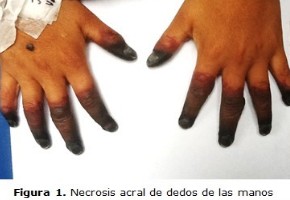Symmetrical Peripheral Gangrene associated to norepinephrine in a patient with urosepsis due to Escherichia coli
Abstract
Background: symmetrical peripheral gangrene is a devastating complication associated with norepinephrine use in critically ill patients, characterized for ischemia of acral distribution in absence of large vessel obstruction.
Objective: to underscore the relevance of a rare complication to a medication of common use and a frequent disease.
Clinical case: a thirty-six-year-old woman with history of urolithiasis was admitted to the emergency room for septic shock secondary to acute pyelonephritis. She was transferred to the intensive care unit where antimicrobial therapy, mechanical ventilation and vasopressor support with norepinephrine was given. Four days later, progressive cyanosis of the four limbs became apparent, evolving to symmetrical peripheral gangrene. Cultures revealed the presence of a usual resistance pattern Escherichia coli. Given the presence of severe anemia and thrombocytopenia, disseminated intravascular coagulation was suspected. A poor response was observed in the patient as she underwent plasmapheresis and glucocorticoid pulse therapy, limiting necrosis to acral regions of the limbs. In the end required amputation of the digits. The laboratory studies rule out other possible etiologies leading to a final diagnosis of SPG associated to vasopressor support.
Conclusions: a case of digital necrosis in the context of urosepsis is presented. Multiple risk factors where present (severe sepsis, norepinephrine use, Escherichia coli infection). Escherichia coli endotoxemia may have a physiopatological role in these cases.
DeCS: GANGRENE; NOREPINEPHRINE; ESCHERICHIA COLI; ADULT; CASE REPORTS.
Downloads
References
1.Warkentin TE. Ischemic limb gangrene with pulses. N Engl J Med. 2015;373(7):642-55.
2.Han KOT ACh, Tet Sen H. Four limb amputations due to peripheral gangrene from inotrope use– Case report and review of the literature. Int J Surg Case Rep. 2015;14:63-65.
3.Jiang LT JL, Chang HR. Symmetrical peripheral gangrene in sepsis after treatment with inotropes. Tzu Chi Med J. 2017;29(2):121-124.
4.Warkentin TE, Cook RJ, Sarode R, Sloane DA, Crowther MA. Warfarin-induced venous limb ischemia/gangrene complicating cancer: a novel and clinically distinct syndrome. Blood. 2015;126(4):486-93.
5.Rintala E, Kauppila M, Seppälä OP, Voipio-pulkki LM, Pettilä V, Rasi V, et al. Protein C substitution in sepsis-associated purpura fulminans. Crit Care Med. 2000;28(7):2373-8.
6.Ghosh SK, Bandyopadhyay D, Ghosh A. Symmetrical peripheral gangrene: a prospective study of 14 consecutive cases in a tertiary-care hospital in eastern India. J Eur Acad Dermatol Venereol. 2010;24(2):214-8.
7.Warner PM, Kagan R, Yakuboff K, Kemalyan N, Palmieri T, Greenhalgh D, et al. Current management of purpura fulminans: a multicenter study. J Burn Care Rehabil. 2003;24(3):119-26.
8.Ramos-Casals M, Stone JH, Cid MC, Bosch X. The cryoglobulinaemias. Lancet. 2012;379(9813):348-60.
9.Schwartz J, Padmanabhan A, Aqui N, Balogun RA, Connelly‐Smith L, Delaney M, et al. Guidelines on the Use of Therapeutic Apheresis in Clinical Practice–Evidence‐Based Approach from the Writing Committee of the American Society for Apheresis: The Seventh Special Issue. J Clin Apher. 2016;31(3):149-338.
10.Shimbo K, Yokota K, Miyamoto J, Okuhara Y, Ochi M. Symmetrical peripheral gangrene caused by septic shock. Plast Surg Hand Surg. 2015;2(3-4):53-6.
11.Patel M, Sachan R, Verma A, Shyam R. Symmetrical peripheral gangrene: Unusual complication of dengue fever. Adv Biomed Res. 2016;5:154.
12.Blarer J, Pfister D, Jandali A, Gutzeit A, John H, Horstmann M. Akrale Nekrosen als Komplikation einer lithogenen Urosepsis. Urologe A. 2014;53(6):871-4.
13.Einhorn J, Levis JT. Dermatologic diagnosis: leukocytoclastic vasculitis. Perm J. 2015;19(3):77-8.
14.Greinacher A. Heparin-induced thrombocytopenia. N Engl J Med. 2015;373(3):252-61.
15.Kuznetsova MV, Maslennikova IL, Nekrasova IV, Shirshev SV. Effect of mixed culture supernatants of Pseudomonas aeruginosa and Escherichia coli on apoptosis, necrosis, and oxidative activity of neutrophils. Doklady biological sciences. 2015 Mar;461(1):112-5.

Published
How to Cite
Issue
Section
License
Copyright: Camagüey Medical Archive Magazine, offers immediately after being indexed in the SciELO Project; Open access to the full text of the articles under the principle of making available and free the research to promote the exchange of global knowledge and contribute to a greater extension, publication, evaluation and extensive use of the articles that can be used without purpose As long as reference is made to the primary source.
Conflicts of interest: authors must declare in a mandatory manner the presence or not of conflicts of interest in relation to the investigation presented.
(Download Statement of potential conflicts of interest)
The Revista Archivo Médico de Camagüey is under a License Creative Commons Attribution-Noncommercial-No Derivative Works 4.0 International (CC BY 4.0).
This license allows others to distribute, to mix, to adjust and to build from its work, even for commercial purposes, as long as it is recognized the authorship of the original creation. This is the most helpful license offered. Recommended for maximum dissemination and use of licensed materials. The full license can be found at: https://creativecommons.org/licenses/












 22 julio 2025
22 julio 2025